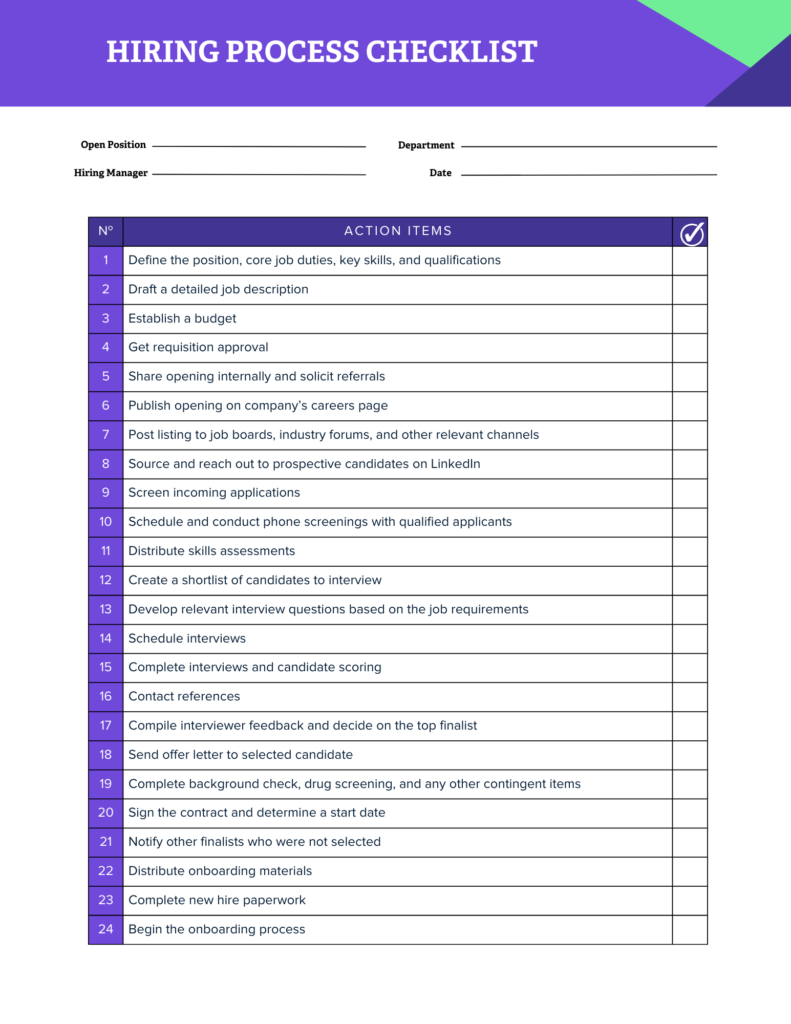Hiring Process Checklist: 24 Steps to Successful Recruitment

Making fast, accurate hiring decisions is essential in today’s ultra-competitive job market. If you want to onboard great people who fit your company culture and have the skills you need to grow your business, you need a clear hiring roadmap.
A hiring process checklist can help you streamline tasks, deliver a consistent candidate experience, and hire accurately. We’ll break down what goes into a good hiring checklist and share a sample you can use and build upon to ensure recruiting efficiency.
What is a Hiring Process Checklist?
A hiring checklist is a step-by-step task list for filling a company’s staffing needs. It outlines everything that needs to happen for hiring to occur, from identifying a need to onboarding a new employee.
A hiring process checklist can be as simple as a bulleted list of high-level tasks or as detailed as a multi-page instruction manual. Whatever the format, this document helps recruiting teams collaborate successfully and hire in an expeditious manner while minimizing unnecessary work.
Why Use a Hiring Process Checklist?
Streamline hiring
A hiring checklist keeps your recruitment process moving. As with any project, it gets done faster when you know exactly what to do. It’s like following a map versus trying to remember and replicate the path you took the last time around. Efficiency is vital to being competitive and avoiding missing out on top talent.
Provide clarity
A visual checklist keeps everyone involved in hiring on the same page. At a glance, anyone can see where the process stands, whether there are any bottlenecks, and what needs to be done next.
Increase consistency
Following a hiring checklist promotes a positive and fair experience for candidates. The consistent set of steps helps ensure all candidates are given equal consideration. It also helps keep your hiring process on par with what other companies in your market are doing.
Ensure compliance
Checking off required tasks as you go verifies that you’ve completed all the necessary legal steps involved in hiring and haven’t missed anything that could get you into trouble. Maintaining detailed records is always a good idea, and following a hiring checklist creates documentation of your hiring activities in case you need to refer back to them.
Promote better hiring
A hiring checklist signifies that you’ve put thought into the hiring process. Careful planning ensures you attract candidates with the right skills, since you’ve taken the time to define what those skills are. The same goes for selecting candidates who are aligned with your company culture; the checklist allows you to literally check off the process of identifying a strong culture fit.
Facilitate continuous improvement
With your hiring steps outlined on paper, it’s easy to change things up, try new processes, and assess optimization. You can continuously fine-tune your workflows and simplify steps as you figure out what works.
Ready to hire someone great?
Speak with our recruiting professionals today.
What to Include in a Hiring Process Checklist
Preparation
What needs to happen before your search can begin? Include steps like identifying skills gaps, drafting job descriptions, defining selection criteria, and getting requisition approvals.
Sourcing
Cover the steps you need to take to build your applicant pool, like posting to job boards and social media, reaching out to candidates on LinkedIn, hosting virtual and in-person recruitment events, and contracting third-party recruiters.
Screening
Outline how you’ll zero in on a shortlist of candidates. Consider steps like defining screening questions, reviewing resumes, conducting phone screens, distributing skills assessments, and reviewing the results.
Related: Pre-Screening Questions to Ask Candidates
Selection
This phase includes many candidate-facing steps, like developing interview questions, scheduling and conducting interviews, scoring candidates, and compiling feedback from interviewers. Note what happens after you’ve identified a winning candidate, like speaking with references and running background checks.
Hiring
A hiring process checklist is particularly helpful for making sure you check all the many logistical boxes involved in making your selected candidate part of your team: making an offer, engaging in negotiations, deciding on a start date, and providing new hire materials.
Onboarding
Determine the tasks required to bring your new hires into the fold, like orientation, training, and completing essential paperwork.
Related: New Hire Checklist
Example Hiring Process Checklist
- Define the position, core job duties, key skills, and qualifications
- Draft a detailed job description
- Establish a budget
- Get requisition approval
- Share opening internally and solicit referrals
- Publish opening on company’s careers page
- Post listing to job boards, industry forums, social media, and other relevant channels
- Source and reach out to prospective candidates on LinkedIn
- Screen incoming applications
- Schedule and conduct phone screenings with qualified applicants
- Distribute skills assessments
- Create a shortlist of candidates to interview
- Develop relevant interview questions based on the job requirements and distribute them among interviewers
- Schedule interviews
- Complete interviews and candidate scoring
- Contact references
- Compile interviewer feedback and decide on the top finalist
- Send offer letter to selected candidate
- Complete background check, drug screening, and any other contingent items
- Sign the contract and determine a start date
- Notify other finalists who were not selected
- Distribute onboarding materials
- Complete new hire paperwork
- Begin the onboarding process
Need help organizing your hiring process?

Tips for Optimizing Your Hiring Process Checklist
Leverage technology to automate tasks
Throughout every hiring phase you cover in your checklist, think about how you’ll leverage your ATS and other technology to streamline tasks. Automating processes like posting to job boards, scheduling interviews, and sending timely candidate communications can save time and eliminate manual steps.
You may want to add a dedicated checklist step for required tech tasks at each phase. For example, you may need to update a candidate’s status in your ATS after the screening phase or start your finalist on a new hire email nurture series after the contract is signed.
Incorporate consistent, tailored candidate engagement
Consider adding steps to your hiring checklist surrounding the candidate experience. For example, at each phase in the process, detail what messages (email, text, or otherwise) will be sent to candidates to communicate the status of your search and what information needs to be included in each one.
Related: The Importance of Candidate Engagement
Identify task ownership to assign accountability
An important but often overlooked step in creating a hiring checklist is to establish the responsible party for each step and any additional team members who need to provide approval or sign off before the next step can be taken. With this information readily available, it’s easier to hold everyone involved in recruiting accountable for their part in keeping the process moving.
Set deadlines
Define how long each step in the process should take. This makes it easy to add the required time for each step together to get an idea of your best-case-scenario hiring timeline. It’s a good reality check to show you how fast (or slow) your process is and identify where steps need to be condensed, improved, or eliminated entirely to accelerate your time to hire.
Analyze data and optimize processes
One novel feature of having a hiring checklist is that you can map various recruiting metrics to their corresponding steps in your checklist to understand the efficiency of each phase of hiring. For example, looking at your average candidate dropoff rate between the phone screening and the interview could tell you whether you’re taking too long to move forward with interviews and, thus, losing out on potentially great hires. By monitoring your recruiting metrics regularly, you can continuously improve the productivity and effectiveness of your recruiters.
The hiring process can be lengthy and complex. Utilizing a well-planned hiring checklist empowers your recruiting team to succeed, moving quickly and with precision to find and onboard the best candidate for the job.
